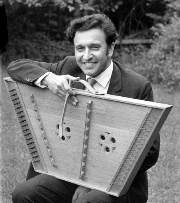CHAPTER
4: Dulcimers in the British Isles since 1800 > Dulcimers
in the later 20th century
Dave Williams, (d.
1997), Totton, Hampshire
To all the
makers and players mentioned so far in this section, the dulcimer
is a subsidiary interest, in many cases something of a novelty
to be exploited for its unusual sound. To discover players with
a deeper interest, we must look to the influence of David Williams,
a buyer for an international electronics firm, whose over-riding
interest in life is involving people in creative music-making
cheaply and easily.
To this end
he has made square guitars, countless bowed psalteries, a simple
crwth, a devil's fiddle (something between a banjo and a cello,
also known as hum-strum) and many other gadgets; he is also
a talented entertainer, with the ability to realise the music
potential of any artifice, whatever its original purpose, but
specialising in melodion and guitar.
|

A
portrait by his mother Ruby, of the proud maker
of his first dulcimer which later became mine and
opened so many doors in so many countries
Click
on the picture for a larger version
and
if you'd like a printable version, 150x150 pixels/inch,
110Kb click

|
|

Detail
from a Gloria painted
by Cornelisz van Oostzanen, dated 1512
|
David's interest
in the dulcimer was first captured by a little entry in The
Observer's Book of Music - as indeed was my own - and when
he consequently saw Jimmy
Cooper's instrument, he decided to have a go at making one;
he borrowed it for a week and produced quite a different instrument,
one which happened to be remarkably similar to that portrayed
in Cornelisz van Oostzanen's painting of 1512, and which is
now my normal performing instrument. David simplified the stringing,
using only double courses, and says of more complex systems,
"I personally can see no advantage, other than being able to
tell more jokes while tuning up"(44); he also added side panels,
so that a lid could be added, having lugs to fit inside these
panels, a spontaneous regeneration of the form of many older
instruments. All his later instruments, however, revert to the
form more normal today, where the blocks themselves form the
sides, and the front and back panels are more nearly flush with
the soundboard.
He has made
two instruments with triple courses, one of them with
only one bridge, for Ashley Hutchings; David considers that
neither has a very satisfactory tone but has no idea why this
should be. More recently, he has made a series of dulcimers
using cedar for the soundboard, all with high bridges, and well-spaced
courses: the tone of these is very luxuriant, almost velvet,
and they sound particularly fine when plucked. All David's instruments
have his personality indelibly printed upon them: bold, clear
and simple, primarily functional, with aesthetic considerations
coming second but nonetheless catered for in his own individual
style.
Plans based
on the more recent instruments have been published in Sing
Out! magazine (44) and more recently in my own book (45)
and were privately circulated before that, and a number of enthusiasts
have made instruments from them: Neil Bettinson, Whitehaven;
Paul Buckle, Winchester; Bob Green, Bristol; Griff
Jones, Lutterworth; Marek Kaminski, Wolverhampton;
Bob Longstaff, Hersham;
Pru, Loughborough; David Phillpot, Reading; Dick
Spencer, Nottingham; Bruce Watson, London; Christopher
White, Sevenoaks.
|
You can read the address given
by Rev. David Slater at Dave's funeral
|
|

![]()
